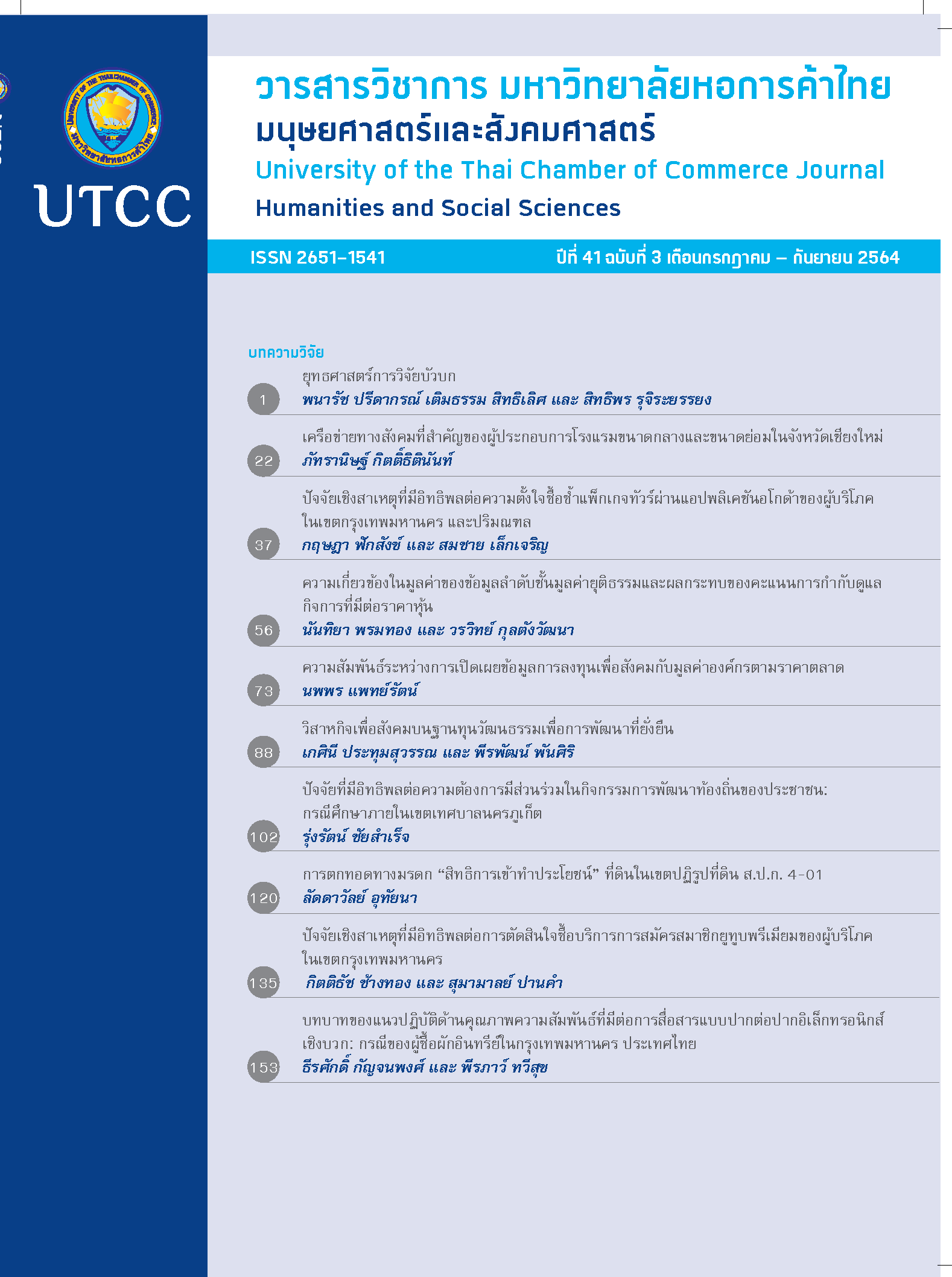Social Enterprise Based on Cultural Capital for Sustainable Development
Main Article Content
Abstract
This research article aimed to study 1) Entrepreneurship potential of social enterprises based on cultural capital, 2) knowledge level on social enterprises of producer groups and their partners, and 3) guidelines for enhancing social enterprises to sustainable development goals. The 4 social enterprise projects; working in Bangkok, Chiang Mai, Khon Kaen and Songkhla, supported by Thai Health Fund were selected as samples. This study incorporated the following tools in data collection process; in-depth interview, focus group discussion, self- assessment, and participatory observation. The major findings showed that cultural capital of all projects was high potential. Cultural capital was developed for social enterprise operation, integrating human, social, natural and physical capitals. As a whole entrepreneur performance was at a moderate level. The general knowledge on social enterprise of producer groups and their partners was at a moderate level. Therefore, the guidelines for strengthen them in order to be sustainable social enterprises, should focus on mindset and entrepreneurial skills development. Training, consulting and business incubating become necessary.
Article Details

This work is licensed under a Creative Commons Attribution-NonCommercial-NoDerivatives 4.0 International License.
ลิขสิทธิ์ของบทความ
ผลงานที่ได้รับการตีพิมพ์ถือเป็นลิขสิทธิ์ของมหาวิทยาลัยหอการค้าไทย ห้ามมิให้นำเนื้อหา ทัศนะ หรือข้อคิดเห็นใด ๆ ของผลงานไปทำซ้ำ ดัดแปลง หรือเผยแพร่ ไม่ว่าทั้งหมดหรือบางส่วนโดยไม่ได้รับอนุญาตเป็นลายลักษณ์อักษรจากมหาวิทยาลัยหอการค้าไทยก่อน
References
คณะกรรมการนโยบายการท่องเที่ยวแห่งชาติ. (2562). เกณฑ์การพัฒนาการท่องเที่ยวโดยชุมชนของประเทศไทย. สืบค้นจาก http://anyflip.com/agwsk/tyrq
Cabbages & Condom Restaurant. (2560). สืบค้นเมื่อ 18 มกราคม 2564, จาก https://firstphach.wixsite.com/socialenterprise/cabbages-and-condoms
บุญวรา สุมะโน. (2563). โครงการสำรวจสภาพการณ์ธุรกิจเพื่อสังคมในประเทศไทย. สืบค้นเมื่อ 16 มกราคม 2564, จาก http://www.imageplus.co.th /content-detail.php?id=1183
พจนา สวนศรี. (2546). คู่มือการจัดการท่องเที่ยวโดยชุมชน. กรุงเทพฯ: โครงการท่องเที่ยวเพื่อชีวิตและธรรมชาติ.
พระราชบัญญัติส่งเสริมวิสาหกิจเพื่อสังคม พ.ศ. 2562. (2562). ใน ราชกิจจานุเบกษา (น.32-56). สืบค้น จาก https://po.opdc.go.th/file/reader/RHx8NDU0NHx8ZmlsZV91cGxvYWQ
พิมพิกา พูลสวัสดิ์, และสุวิต ศรีไหม. (2561). วิสาหกิจเพื่อสังคมกับการพัฒนาสังคมอย่างยั่งยืน: บทเรียนจากต่างประเทศและแนวทางการพัฒนาในประเทศไทย. วารสารบริหารธุรกิจ เศรษฐศาสตร์และการสื่อสาร, 13(3): 15-32.
ไพโรจน์ ธีระประภา. (2558). อัตลักษณ์ของที่ระลึกและกราฟิกดีไซน์สะท้อนพื้นถิ่น. สืบค้นเมื่อ 16 มกราคม 2564, จาก https://www.bundanthai.com/th/news/9
สมเกียรติ สกุลสุรเอกพงศ์. (2561). ปัจจัยที่มีอิทธิพลต่อประสิทธิภาพกิจการเพื่อสังคมในประเทศไทย. วารสารการเมือง การบริหาร และกฎหมาย, 8(1), 139-161. สืบค้นจาก http://www.polsci-law.buu.ac.th/journal/document/8-1/4.pdf
สุวรรณี คำมั่น และคณะ. (2551). ทุนทางสังคมกับการพัฒนาทุนมนุษย์. เอกสารนำเสนอในการสัมมนาวิชาการประจำปี 2551 เรื่องสู่การเติบโตอย่างมีคุณภาพและยั่งยืน กลุ่มที่ 3 ทุนมนุษย์ ร่วมจัดโดย มูลนิธิชัยพัฒนา, สํานักงานคณะกรรมการพัฒนาการเศรษฐกิจและสังคมแห่งชาติ และมูลนิธิสถาบันวิจัยเพื่อการพัฒนาประเทศไทย วันที่ 29-30 พฤศจิกายน 2551 ณ โรงแรมแอมบาสซาเดอร์ซิตี้จอมเทียน ชลบุรี. สืบค้นจาก http://tdri.or.th/wp-content/uploads /2012/11/g3_6_suwanee_final.pdf
Bourdieu, P. (1986). The forms of capital. In J. G. Richardson (Ed.), Handbook of theory and research for the sociology of education (pp.251-248). New York, NY: Greenwood Press.
Elkington, J. (1997). Cannibals with forks: The triple bottom line of 21st century business. Oxford, England: Capstone.
Throsby, D. (1999). Cultural capital. Journal of Cultural Economics, 23(1): 3-12.


